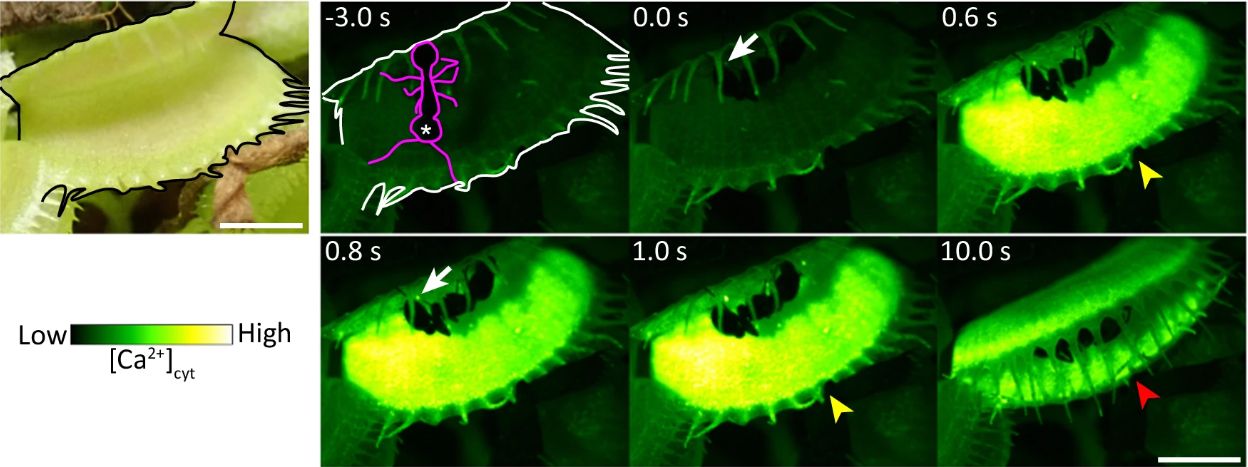Science
New Research Unveils Mechanosensor Behind Venus Flytrap’s Rapid Response

Carnivorous plants continue to captivate researchers, especially the Venus flytrap (Dionaea muscipula), which employs a remarkable spring-loaded mechanism to trap its prey. Recent research published in Nature Communications by a team led by Hiraku Suda sheds light on the mechanosensor responsible for the plant’s quick reflexes, revealing insights into how these fascinating organisms interact with their environment.
The study identifies a mechanosensor named DmMSL10, crucial for the rapid calcium response seen in the Venus flytrap. Previous research acknowledged that the sensory hairs along the plant’s leaves respond to specific stimuli through calcium threshold signals, yet the underlying mechanism remained largely unexplored.
Suda and his colleagues conducted experiments that involved creating a knockout variant of the D. muscipula where the DmMSL10 channel was absent. This alteration allowed them to assess the role of this stretch-activated chloride ion channel in the plant’s sensory response. They found that while both the wild-type and knockout variants experienced calcium ion release upon mechanical stimulation, the knockout variant exhibited a significantly reduced rate of action potential generation.
In a practical demonstration, ants were allowed to roam on the leaves of both plant types. The wild-type Venus flytrap successfully captured the first ant that ventured onto its leaf, while the knockout variant showed no movement even after multiple ants failed to elicit a calcium signal strong enough to trigger the leaf’s closure.
This research provides a clearer understanding of how D. muscipula and similar plants generate long-range calcium signals, critical for their predatory habits. The findings not only enhance our grasp of plant biology but also pave the way for further studies on the evolution of similar mechanisms in animals.
As scientists continue to explore the intricacies of plant responses, this study marks a significant advancement in understanding the rapid movements of carnivorous plants, potentially unraveling mysteries of their evolutionary adaptations over time.
-

 Science2 weeks ago
Science2 weeks agoIROS 2025 to Showcase Cutting-Edge Robotics Innovations in China
-

 Politics2 weeks ago
Politics2 weeks agoJudge Considers Dismissal of Chelsea Housing Case Citing AI Flaws
-

 World2 weeks ago
World2 weeks agoBravo Company Veterans Honored with Bronze Medals After 56 Years
-

 Lifestyle2 weeks ago
Lifestyle2 weeks agoStone Island’s Logo Worn by Extremists Sparks Brand Dilemma
-

 Top Stories2 weeks ago
Top Stories2 weeks agoIndonesia Suspends 27,000 Bank Accounts in Online Gambling Crackdown
-

 Sports2 weeks ago
Sports2 weeks agoMel Kiper Jr. Reveals Top 25 Prospects for 2026 NFL Draft
-

 Health2 weeks ago
Health2 weeks agoStartup Liberate Bio Secures $31 Million for Next-Gen Therapies
-

 Health2 weeks ago
Health2 weeks agoTop Hyaluronic Acid Serums for Radiant Skin in 2025
-

 World2 weeks ago
World2 weeks agoHoneywell Predicts Record Demand for Business Jets Over Next Decade
-

 Sports2 weeks ago
Sports2 weeks agoYamamoto’s Mastery Leads Dodgers to 5-1 Victory in NLCS Game 2
-

 Politics2 weeks ago
Politics2 weeks agoNew Jersey Voters Urged to Register Ahead of November Election
-

 Lifestyle2 weeks ago
Lifestyle2 weeks agoMary Morgan Jackson Crowned Little Miss National Peanut Festival 2025









